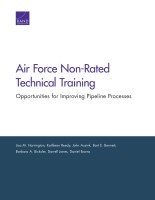| 来源类型 | Research Reports
|
| 规范类型 | 报告
|
| DOI | https://doi.org/10.7249/RR2116
|
| ISBN | 9780833098863
|
| 来源ID | RR-2116-AF
|
| Air Force Non-Rated Technical Training: Opportunities for Improving Pipeline Processes |
| Lisa M. Harrington; Kathleen Reedy; John A. Ausink; Bart E. Bennett; Barbara Bicksler; Darrell D. Jones; Daniel Ibarra
|
| 发表日期 | 2017
|
| 出版年 | 2017
|
| 页码 | 117
|
| 语种 | 英语
|
| 结论 |
Inefficiencies in the Technical Training Planning Process Stem From:- Unrealistic expectations associated with changing requirements. Two different perspectives concerning end strength management emerged: one held by those at headquarters and one by those in the field.
- Lack of agility in responding to changing requirements.
- Insufficient visibility into technical training capacity. The inability to view schoolhouse capacity contributes to the lack of flexibility in the technical training pipeline.
- Lack of readily available information to support execution planning.
- Missing participants in the planning process. From requirements planning to execution planning, the absence of key actors in the planning process can cause delays in critical information sharing.
- Complications of guard and reserve planning. Across 2nd Air Force, the guard and reserve fill on average only 65–70 percent of the seats allocated to them.
Inefficiencies in the Flow of Students Through the Pipeline Stem From:- Inefficiencies associated with time not in training.
- Lack of realistic and consistent metrics, which can provide false perceptions of the status of individual students, the instructor pool, required resources, and the success of the training system as a whole.
Resource Insufficiencies Stem From:- Improper rightsizing of the supply of instructors. Finding the right balance between having too many instructors or too few is the most significant resourcing challenge for technical training.
- Inadequate resourcing of training management and instructional systems, which can seriously undermine the delivery of training and lead to long student wait times and increased costs.
|
| 摘要 |
- Develop a capacity visibility system. Air Education and Training Command (AETC) should develop, fund, and field an information system to enhance visibility into individual pipeline capacity.
- Develop a flow visibility system. The Air Force needs a system that would provide visibility into the flow of students in the pipeline. Formalizing a rapid, flexible system and appropriate policy to accompany it will allow AETC to more effectively utilize training seats.
- Review and update instructor pricing methods and formulas and manning policies. Updated pricing methods should take into account instructor manning standards and personnel policies that have changed since the standards were first developed.
- Reinvigorate technical training pipeline modeling capabilities. Embedding estimation models within the AETC information architecture will help to rapidly provide estimates of the effect of planning, resource, or scheduling changes on pipeline costs and capacity.
- Identify and track effective metrics. Current metrics need to be reviewed for their utility; such a review can also help identify new metrics that could provide additional insight into the management of pipeline processes. Once a set of metrics is established, the information must be accessible to the appropriate management levels.
- Improve management and communication across all levels of the pipeline. Improvements that can address inefficiencies in management and communication include setting and enforcing limits on changes in training targets in the year of execution, standardizing the role of career-field managers in the planning process, and being more accountable with guard and reserve seats.
|
| 主题 | Military Education and Training
; Military Personnel Retention
; Technical Professions
; United States Air Force
|
| URL | https://www.rand.org/pubs/research_reports/RR2116.html
|
| 来源智库 | RAND Corporation (United States)
|
| 引用统计 |
|
| 资源类型 | 智库出版物
|
| 条目标识符 | http://119.78.100.153/handle/2XGU8XDN/108641
|
推荐引用方式
GB/T 7714 |
Lisa M. Harrington,Kathleen Reedy,John A. Ausink,et al. Air Force Non-Rated Technical Training: Opportunities for Improving Pipeline Processes. 2017.
|
|
文件名:
|
x1531143519186.jpg
|
|
格式:
|
JPEG
|

|
文件名:
|
RAND_RR2116.pdf
|
|
格式:
|
Adobe PDF
|
除非特别说明,本系统中所有内容都受版权保护,并保留所有权利。